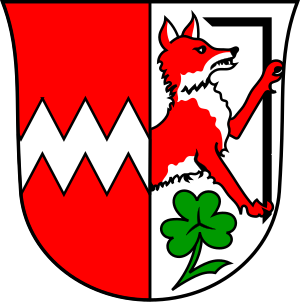Andreas Georg von Murach

Andreas Georg von Murach , also Endres Jörg von Murach, († June 1585 in Offenheim ) came from the noble family von Murach , had extensive possessions between Schönsee and Winklarn and was Land Marshal of the Upper Palatinate from 1578 until his death .
Life
Own possessions
Andreas Georg Schwarzenberg and Kürnberg inherited from his father Georg von Murach auf Stamsried , property that had come into the family through his mother Elisabeth Zenger . Steinberg fell to him in 1561 or 1562 from the Egloffstein inheritance. Winklarn brought his wife Anna into the marriage.
On January 29, 1580, Emperor Rudolf II (HRR) enfeoffed Andreas Georg von Murach on Kürnberg and Winklarn and his wife Anna a. a. with the two desolate castles Frauenstein and Reichenstein, today the castle ruins Reichenstein (Upper Palatinate) , the little town of Schönsee and the villages of Weiding and Pondorf .
In addition, he was co-owner of Kager from 1550 and, after the death of his father in 1552, sole owner until his death.
Coat of arms for Winklarn
Andreas Georg von Murach was the owner of the Winklarn estate and granted the market the right to seal and a coat of arms in 1577.
The front field of the coat of arms shows the family coat of arms of the Lords of Murach with the silver zigzag bar. The fox establishes the connection to the noble family of the foxes of Wallburg. Thomas Fuchs von Wallburg acquired Winklarn at the beginning of the 16th century. His successor was his son Hans Fuchs von Wallburg , father of Anna, the wife of Andreas Georg von Murach. Then his stepson, Hans Christoph Fuchs von Wallburg , took over the rule of Winklarn. The coat of arms symbolizes in particular the family connection between the two noble families of Murach and Fuchs in the 16th century.
Land Marshal of the Upper Palatinate
After the death of Louis VI. In October 1583 Andreas von Murach was involved in the dispute about the future direction of the Upper Palatinate in matters of faith. Louis VI. had successfully strengthened Lutheranism in the Upper Palatinate, although his father wanted to teach him Calvinism . When he died, his son was not yet capable of governing. His brother Johann Kasimir took over the affairs of state as administrator and immediately campaigned for Calvinist concerns. The estates did not agree with this. Andreas von Murach wrote a very brisk letter to the administrator to refrain from changing the religious rules and thus promoted the conflict between the two camps.
As a land marshal he was also involved artistically and, before 1581, engaged the painter Andreas Solis (1550–1592), son of the well-known Nuremberg artist Virgil Solis. He painted over 300 colored coats of arms for the Tucherbuch and worked for the Teutonic Order in Ellingen after 1581.
When Andreas died in a wild bath near Offenheim in June 1585, his body was transferred to Nuremberg. A funeral procession was carried out for him there as if he had died in Nuremberg. That was how he had set it in his will. In the churches was written: "The Gestreng, Edel and Vest, Andreas von Murach, Kirnberg, Schwarzenberg and Wincklern, the Upper Elector Palatinate Land-Marshal". The funeral procession led out to Lauf.
His successor as Land Marshal of the Upper Palatinate was his stepson Hans Christoph Fuchs von Wallburg.
family
His father was Georg Albrecht von Murach from Stamsried, his mother Elisabeth Zenger, heiress of Schwarzenberg and Kürnberg. In 1540 he married Anna Fuchs von Wallburg, daughter of Hans Fuchs von Wallburg and Verena von Schwarzenstein, and widow of David, also from the noble family of the Fuchs von Wallburg. They had a daughter Anna, who first married Ulrich von Pranckh and then Hans von Wolffsthal zu Thanstein.
The noble families of the von Murach and the Fuchs von Wallburg were closely related. Andreas brother Georg was married to the sister of his wife Barbara.
literature
- Emma Mages: Historical Atlas of Bavaria, part of old Bavaria , issue 61. Oberviechtach, Munich 1996, ISBN 3-7696-9693-X ( online ).
- Georg Hager: The art monuments of the Kingdom of Bavaria, Upper Palatinate and Regensburg, VII . District Office Oberviechtach, Munich 1906 ( full text ; PDF; 5.5 MB)
- Thorough information and an idea of what the Königl located in the principality of the Upper Palatinate. Böhaimbischen fiefdom Gut Schönsee and its pertinentiis before a quality. 1675
Individual evidence
- ^ Negotiations of the Historical Association of the Upper Palatinate and Regensburg, 1841, Volume 6, page 102
- ^ House of Bavarian History: Wappengeschichte Markt Winklarn
- ↑ Patrizius Wittmann: "History of the Reformation in the Upper Palatinate." 1847, page 79
- ↑ Manfred H. Grieb: Nürnberger Künstlerlexikon: Visual artists, artisans, scholars, collectors, cultural workers and patrons from the 12th to the middle of the 20th century . 2007, page 1447
- ↑ 1585 funeral sermon: Bey the Christian Begengnus des Gestrengen Edlen vn (d) Ehrnvehsten Herr, Georgen Andres von Murach, on Kürnbergk and Wincklern etc., etc. of the Upper Electoral Palatinate Landmarschalln blessed memorial, the eighth July of this 1585 year, done at Amberg Through M. Martinum Oberndorffer's parents, preacher there himself (source: Main State Archives Düsseldorf, branch Kalkum-Schloß funeral sermon collection from Stolberg, No. 16883).
- ^ Georg Ernst Waldau, Contributions to the History of the City of Nuremberg, 1789, Volume 4, page 166 ff.
- ↑ Johann Gottfried Biedermann: Gender register of the Reichs-Frey immediate knighthood of Francken, praiseworthy place Steigerwald, Bayreuth 1748, plate CCLXVI
| personal data | |
|---|---|
| SURNAME | Murach, Andreas Georg von |
| ALTERNATIVE NAMES | Murach, Endres Jörg von |
| BRIEF DESCRIPTION | Land Marshal of the Upper Palatinate |
| DATE OF BIRTH | 15th century or 16th century |
| DATE OF DEATH | June 1585 |
| Place of death | Offenheim |
